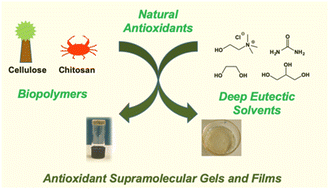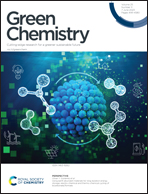Polysaccharide-based supramolecular bicomponent eutectogels as sustainable antioxidant materials†
Abstract
In this work, we obtained supramolecular gels in deep eutectic solvents (DES) from polysaccharides like chitosan and chitosan : cellulose composites. We thoroughly characterized our gels by determining the minimum gelation concentration, as well as their porosity and swelling. We also investigated their mechanical properties by rheology, and morphology by scanning electron measurements. These properties were mainly influenced by the number of hydrogen bond sites on the hydrogen bond donor, (HBD), while FTIR-ATR investigation suggested that, upon gelation, cholinium cations interpose between polysaccharide chains affecting interchain hydrogen bonding. Our gels also exhibited self-healing and load bearing ability and proved injectable. Subsequently, we evaluated antioxidant ability of the gels by the 2,2-diphenyl-1-picrylhydrazyl radical (DPPH) assay. We found that gelation of the DES reduces their radical scavenging ability, so we doped the gels with natural antioxidants like trans-ferulic acid (TA) and α-tocopherol (VE), finding that their high scavenging ability is fully preserved in the gel matrix. We then prepared films from one of the gels and evaluated their stability to sunlight and exposure to water, finding that the TA-doped film was the most resistant to UV-light, and retained its radical scavenging ability even after being exposed to significant amounts of water.



 Please wait while we load your content...
Please wait while we load your content...